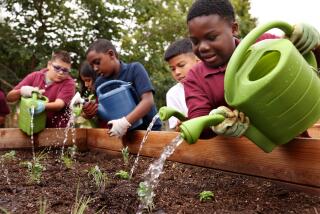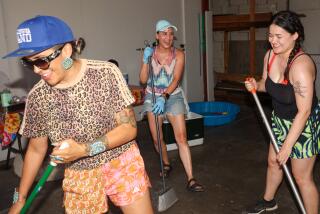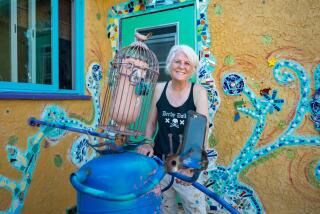Community, School Join to Push Art Center
At most San Diego city schools, resident artist programs have resulted in a mural or another type of permanent art work that students helped create.
But art has spawned something far more ambitious at Carver Elementary near Chollas Reservoir in Oak Park. Not only have Carver students learned some of the basics of art, but their parents have participated in classes as well.
Now, students and parents have joined with the school’s staff and other Oak Park residents to propose a campus art and literature structure that could reshape Carver into a community center.
Already, the school has received detailed architectural drawings, free at this point, as well as the support of neighborhood organizations and is now putting the final touches on a $400,000 request for funds it hopes the San Diego City Council will forward to federal officials this spring through its Community Block Development Grant program. Other fund-raising efforts are under way as well, since school district funds are not available for the plan. School money will be used to maintain the center.
San Diego city schools trustees are expected today to give their official support to the school-community effort.
“I think it’s a fascinating proposal,” schools Supt. Tom Payzant said. “I think it’s helped spawn a new-found enthusiasm at the school to make things happen” for students. Carver has long had no real image, good or bad, as one of the system’s 106 elementary sites.
The proposed community center is the latest effort by Principal Joanne Wall to improve student performance by pushing teacher participation in decision-making and coming up with projects to involve more parents.
Already, the school is part of a community effort spawned by a group of San Diego Chargers players to help students along nearby Bates Street--an area with heavy drug activity--by starting up a neighborhood center. More than 30 Carver teachers and aides volunteer to tutor and counsel at least once a week at the center.
The school is also a partner of the San Diego Museum of Art, where 173 Carver parents attended a picnic sponsored by Wall and her teachers in September on the museum lawn followed by a special tour of the Frank Lloyd Wright exhibit. For two-thirds of the students, it was their first trip ever to the museum, Wall said.
“A lot of the credit for the center proposal goes to (artist-in-residence) Jeannie Cartabiano,” said second-grade teacher Sherryl Case, one of several teachers at Carver who jumped on Cartabiano’s suggestion last year to set up art classes for both parents and students after school.
Wall said that Cartabiano’s classes gave parents a chance at “natural involvement,” rather than having contacts only when children have classroom-related problems that need attention.
The after-school classes became a catalyst for parents and students to work on a mural at Children’s Hospital, which was dedicated last week.
“All of this got the community beginning to see themselves as part of the school, and we then started to brainstorm how we could incorporate art as part of the regular curriculum,” Case said. The result was the proposed community arts center.
Although Wall, the principal, said the plan first sounded akin to something out of “Alice in Wonderland,” she gradually came to believe it possible. A community center could be located at a school, she was told by district property administrators.
Cartabiano persuaded Kotaro Nakamura, a San Diego architect and lecturer at San Diego State University, to draw up detailed plans, which call for a wood-and-glass building in front of a bank of enclosed art studios, surrounded by detailed landscaping. Nakamura agreed to do the plan before any funds had been raised for payment.
“Not only could classes be held in the center, but the neighborhood and nearby schools could study art-related activities or have poetry readings and other events there as well,” Wall said. The garden would be targeted for science-related experiments, such as student investigation of drought-resistant plants.
“I was just a catalyst for all of this,” said Cartabiano. “Now a lot of others are taking the ball forward and trying to show that art is not the 19th-Century notion of a painting here or sculpture there, separate from other disciplines. Now you can use it with math and reading in an interdisciplinary sense.”
For Wall, the bottom line “is that this allows us to teach better, to bring in more resources from the outside, to make things better for kids.”
However, as Wall is the first to admit, the center cannot be built with proceeds simply from bake sales. “We’d like the City Council to understand that this proposal can be a way for schools and the city to work together, especially where the school district commits itself to maintaining a center such as that proposed,” Wall said.
In attempting to garner federal funds, the Carver center will compete, along with a host of other projects submitted by various community groups from throughout the city, said Faith Triggs, an aide to Councilman Wes Pratt, whose district includes the school site.
Pratt has agreed to include the school plan on a preliminary list that will be circulated among council members in March, Triggs said. Members will then indicate which projects in their districts they will give priority, she said. Only those projects stand a realistic chance of qualifying for funding, she said.
More to Read
Sign up for Essential California
The most important California stories and recommendations in your inbox every morning.
You may occasionally receive promotional content from the Los Angeles Times.










